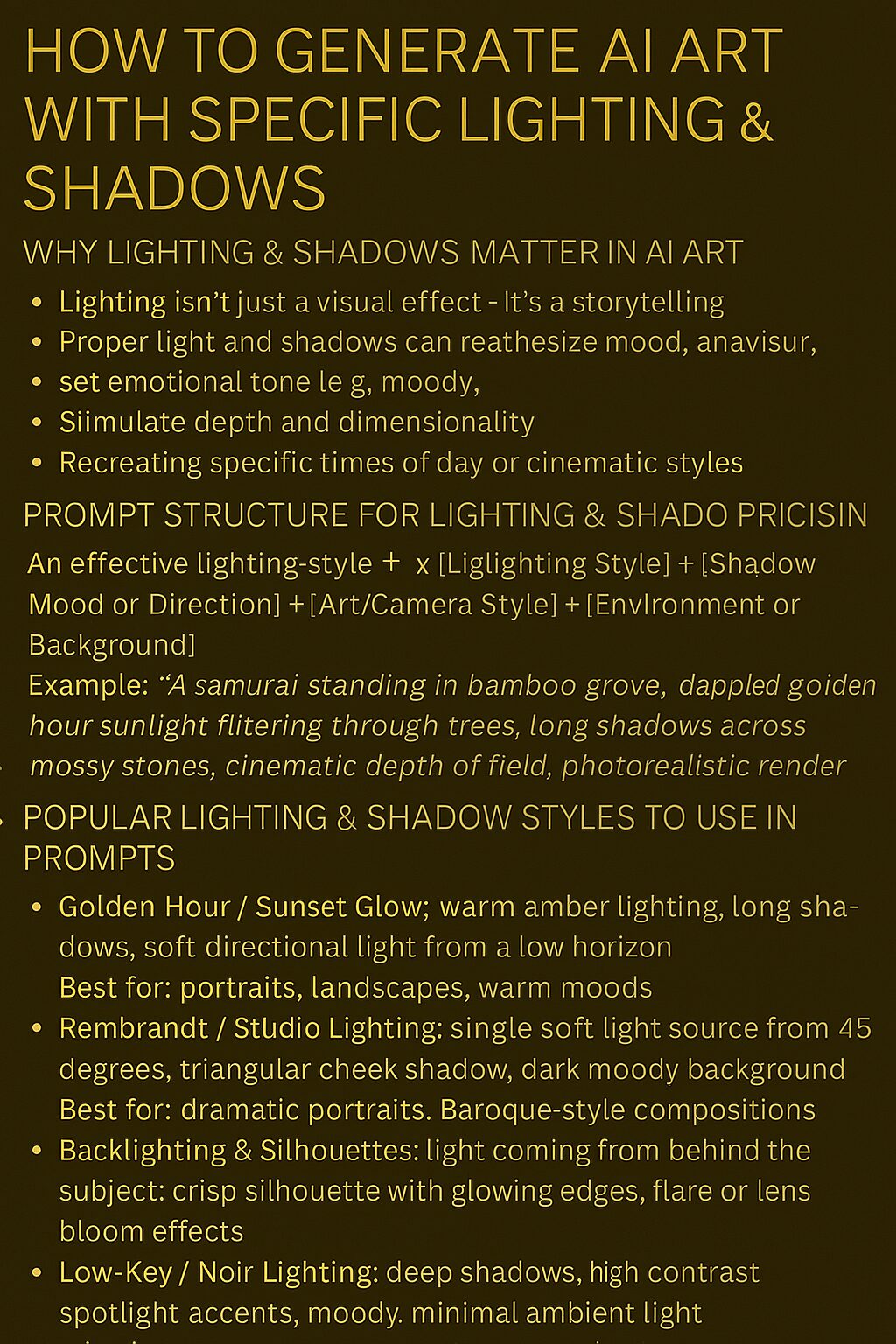Introduction
Whether you’re crafting cinematic environments, atmospheric portraits, or stylized still life images, lighting and shadows are essential for realism, mood, and visual depth in AI art. Using platforms like MidJourney, DALL·E, or Stable Diffusion, you can achieve stunning results—if you know how to prompt correctly.
This guide breaks down how to write AI art prompts that highlight specific lighting conditions and shadow techniques, with SEO-friendly formatting and discoverable phrasing to enhance visibility and creative success.
💡 Why Lighting & Shadows Matter in AI Art
Lighting isn’t just a visual effect—it’s a storytelling device. Proper light and shadow placement can:
- Emphasize subject contours and textures
- Set emotional tone (e.g., moody, romantic, mysterious)
- Simulate depth and dimensionality
- Recreate specific times of day or cinematic styles
Understanding how to communicate these visual intentions via text is key for prompt engineering.
✍️ Prompt Structure for Lighting & Shadow Precision
An effective lighting-focused prompt typically follows this pattern:
[Subject/Scene] + [Lighting Style] + [Shadow Mood or Direction] + [Art/Camera Style] + [Environment or Background]
Example:
> “A samurai standing in a bamboo grove, dappled golden hour sunlight filtering through trees, long shadows across mossy stones, cinematic depth of field, photorealistic render.”
🌇 Popular Lighting & Shadow Styles to Use in Prompts
Here are descriptive phrases you can integrate into your prompts for specific visual outcomes:
1. Golden Hour / Sunset Glow
- warm amber lighting
- long shadows
- soft directional light from a low horizon
✅ Best for: portraits, landscapes, warm moods
2. Rembrandt / Studio Lighting
- single soft light source from 45 degrees
- triangular cheek shadow
- dark moody background
✅ Best for: dramatic portraits, Baroque-style compositions
3. Backlighting & Silhouettes
- light coming from behind the subject
- crisp silhouette with glowing edges
- flare or lens bloom effects
✅ Best for: emotional tone, storybook vibes, mysterious subjects
4. Low-Key / Noir Lighting
- deep shadows, high contrast
- spotlight accents
- moody, minimal ambient light
✅ Best for: horror, crime, or vintage aesthetics
5. Overhead Light / Harsh Midday Sun
- crisp shadows directly beneath subject
- strong contrast and color bleaching
- blue-toned shadow edges
✅ Best for: realism, outdoor scenes, fashion or desert themes
🔍 SEO Tips for AI Art with Lighting-Specific Content
To get your artwork discovered:
✅ Use Keyword-Rich Titles:
- “Best AI Prompts for Moody Lighting in Digital Art”
- “How to Create Sunset Scene in MidJourney with Soft Shadows”
✅ Long-Tail Keywords Examples:
- “AI prompt for overhead lighting on minimalist sculpture in soft shadow”
- “Backlit AI portrait with cinematic rim light and warm haze”
✅ Alt Text and Descriptions:
- “AI-generated noir scene with side lighting and dramatic cast shadows”
✅ Hashtags for Visibility:
- #LightingPrompt #CinematicAIArt #AIShadows #PromptCrafting #VisualMoodAI
🎨 Final Thoughts
Lighting is the soul of an image—and with precise AI art prompts, you can replicate any cinematic moment or mood-laden setup with clarity and control. Whether it’s a character emerging from shadow or a sun-drenched field glowing in gold, your descriptions determine what the AI sees—and how your viewers feel.

